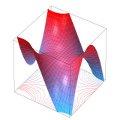
Le Séminaire a lieu le Mardi à 11h00 en salle de conférence du LJAD
Exposés passés
Septembre
| Mardi 19 Septembre | Goulnara Arzhantseva (University of Vienna) |
|
Résumé
We discuss various still open questions on approximations of finitely generated groups, focusing on finite-dimensional approximations such as residual finiteness and soficity. We survey our results on the existence and stability of metric approximations. We suggest a few conjectures, e.g. on Gromov hyperbolic groups and their infinite monster limits. The setting is rather general and the involved concepts are transversal to various areas of mathematics. Based on joint works with Liviu Paunescu (Bucharest). |
Octobre
| Mardi 17 Octobre | Stefano Baranzini (SISSA) |
|
Résumé
In this talk, I will focus on a class of 4d mechanical systems on a surface Σ with a potential V having a finite number of singularities C := {c1, . . . , cn} of the form V (q) ∼ Cid(ci, q)^{−αi} , Ci > 0, αi ≥ 1 and q ∈ O(ci). The first result I will present is about existence: there are periodic solutions in many conjugacy classes of π1(Σ, C). Using this fact, I will construct an invariant set for the system which admits a semi-conjugation with the Bernoulli shift. The second result I will discuss investigates when the semi-conjugation is actually a conjugation and the invariant set constructed displays a chaotic behaviour. This happens, for instance, under some negativity condition on the curvature of Σ and for large values of the energy. Much emphasis will be put on the interplay between geometry, topology and variational methods. This is a joint work with Gian Marco Canneori |
Novembre
| Mardi 7 Novembre | David Burguet (LPSM) |
|
Résumé
|
| Mardi 14 Novembre | Simon Allais (IRMA) |
|
Résumé
En 2000, Eliashberg et Polterovich introduisirent la notion d’ordonnabilité pour étudier la structure des groupes de contactomorphismes et des classes d’isotopie de sous-variétés legendriennes. En peu de mots, le groupe des contactomorphismes est ordonnable si la relation binaire sur les flots de contact au temps 1 naturellement induite par l’ordre partiel sur leurs hamiltoniens est elle-même un ordre partiel. Au cours des deux dernières décennies, ordonnabilité et non-ordonnabilité ont été principalement étudiées au moyen de selecteurs spectraux basés sur des théories dérivées de celle de Floer et sur les fonctions génératrices. Dans cet exposé, nous expliquerons en quoi l’ordonnabilité est équivalente à l’existence de sélecteurs spectraux et en donnerons quelques applications. |
Janvier
| Mardi 16 Janvier | Santiago Barbieri (Universitat de Barcelona) |
|
Résumé
As it is well-known, the steepness property is a local geometric transversality condition on the gradient of C2 functions which proves fundamental in order to ensure the stability over long timespans of integrable Hamiltonian systems that undergo a small perturbation. Though steepness is generic - both in measure and in topological sense - among functions of high enough regularity, the original definition of this property is not constructive and, up to very recent times, the few existing criteria to check steepness were non-generically verified and applied only to functions depending on a low number of variables. By combining Yomdin s Lemma on the analytic reparametrization of semi-algebraic sets together with non-trivial estimates on the codimension of suitable real algebraic varieties, in this talk I will state explicit algebraic criteria for steepness which are generically verified and apply to functions depending on any number of variables. This constitutes a very important result for applications, e.g. in celestial mechanics. The criteria can be constructed recursively and are based on algebraic equalities involving the derivatives of the studied function up to any given order and external real parameters, some of which belong to compact sets and some others to non-compact sets. Moreover, it can be shown that, generically, the non-compact external parameters can be eliminated from the equalities with the help of a linear quantifier elimination algorithm: this represents a crucial improvement for numerical implementations of the criteria. |
| Mardi 23 Janvier | Thierry Combot (Université de Bourgogne Franche Comté) |
|
Résumé
Consider a n degrees of freedom Hamiltonian H which admits m first integrals, and when restricted to a specific level of these first integrals, admits n-m first integrals. We will see that this notion of integrability does not coincide with Liouville Arnold integrability. Still, most of the classical results hold: for most systems, the dynamic is still quasi periodic on a full measure set of the phase space, and the system is still integrable by quadratures. However, there is also a dense set on which the motion is not quasi periodic, and the angle coordinates are not smooth functions of the actions. We will also explore the consequences for the reduction of Hamiltonian admitting first integrals. |
Février
| Mardi 6 Février | Nikhil Savale (Cologne) |
|
Résumé
Nous montrons qu un domaine pseudoconvexe bidimensionnel de type fini avec une métrique de Kähler-Einstein Bergman est biholomorphe à la boule unité. Cela répond à une vieille question de Yau pour de tels domaines. La preuve utilise des asymptotiques de dérivées du noyau de Bergman le long de chemins tangents critiques approchant de la frontière, où l ordre de tangence est égal au type du point frontière approché. Travail conjoint avec Ming Xiao. |
| Mardi 20 Février | Satoshi Ogawa (Osaka Metropolitan University) |
|
Résumé
In this talk, I will introduce a sufficient condition of the existence of a holomorphic tubular neighborhood of a compact Riemann surface in a non-singular complex surface. This sufficient condition is described by an arithmetical condition of the normal bundle which can be regarded as an analogue of the Brjuno condition for irrational numbers which appears in the theory of 1-variable complex dynamics. |
Mars
| Mardi 5 Mars | Melvin Yeung (University of Hasselt) |
|
Résumé
|
| Mardi 12 Mars | Michele Triestino (Université de Bourgogne Franche Comté) |
|
Résumé
|
| Mardi 19 Mars | Illya Koval (Vienne) |
|
Résumé
|
Archives du séminaire: 2016/2017, 2017/2018, 2018/2019, 2019/2020, 2020/2021, 2021/2022,, 2022/2023
Archives du séminaire géométrie et analyse : 2007/2008, 2008/2009, 2009/2010, 2010/2011, 2011/2012, 2012/2013, 2013/2014, 2014/2015, 2015/2016
Archives du séminaire géométrie et dynamique: ici
Organisation: Zhiyan Zhao (écrire) et Emmanuel Militon (écrire)

